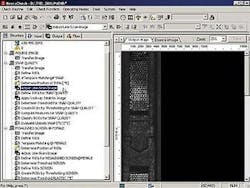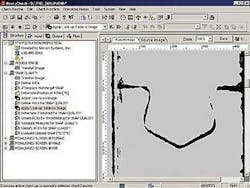Neural-network software targets filter inspection
In checking small automotive filters, a neural-network-based image-processing system proves to be the only platform that meets production-quality requirements.
By Charles H. Small, Contributing Editor
Increasingly, neural networks are finding widespread, practical applications throughout high-technology industries by supporting vision-inspection systems. This development is due primarily to the advent of high-speed, low-cost computers that can support the computationally intensive requirements of neural networks. To machine-vision systems, neural networks bring the ability to process large image files quickly, tolerate high noise levels, and respond rapidly and properly to new and changing parameters. Indeed, neural networks are being used as direct substitutes for autocorrelation, multivariable regression, linear regression, trigonometric, and other regression image-processing techniques.
For example, FSI Machine Vision (Lombard, IL), the North American partner of NeuroCheck GmbH (Remseck, Germany) has integrated a vision inspection system for Norcon Systems (Lombard, IL) using an FSI CVS-700 machine-vision system and NeuroCheck neural-network software. This integrated system includes a gray-scale linescan camera that provides 1k-pixel resolution and comes in a NEMA 1 stainless-steel enclosure.
The vision system uses the Neuro Check Professional software running under Windows 2000. Its central-vision-processor (CVP) controller is housed in a dual-mounting NEMA 1 enclosure (rack or wall), but no display is installed. Standard filtered 24-Vdc high-speed inputs and universal fixed 24-Vdc outputs are provided. NeuroCheck Professional software includes multiple tool and function groups that handle a range of image and object-acquisition, processing, analysis, data-exchange, plant-floor administrative, and storage processes.
Norcon's customer for the vision-inspection system is a manufacturer of filters for automotive applications. FSI bundles the hardware and the software. Norcon, which is an application platform provider and systems integrator, fine-tunes the bundle for a particular application. Norcon does the application-specific programming and other application-specific implementations and ensures that the complete software package works as specified. No additional major software other than Neuro Check was used. Norcon also participates in installing the vision-inspection system on line at the customer's site.
Manual inspection fizzlesPreviously, Norcon's customer had been doing 100% manual inspection to meet the stringent demand that if one filter in a lot was bad, the entire lot would be rejected by the automotive OEM. Because the part is so small, the manual inspection had to be done under magnification. Moreover, the parts are made at the rate of 20 parts per minute. Manual inspection at this rate proved tough, boring, and inaccurate. The customer had encountered difficulty in getting consistent and accurate manual inspections, prompting it to consider a machine-vision approach.Norcon selected FSI equipment and software for this parts-inspection application because FSI supplies a complete, customized, packaged platform chosen from pretested standard models. Otherwise, Norcon would need to buy the line-scan camera, image-processing board, controller, and software separately. It also would have to solve all the component-selection, manufacturing, and compatibility issues and proceed without receiving long-term system-level hardware support from a single manufacturer. The supplied NeuroCheck software works in a user-friendly Windows 95/98/Me/2000 environment. If the end user needs to make changes after the system is handed off, they can do so easily. More important, neural-network processing proved to be the only solution for this vision-inspection application.
The stand-alone CVS-700 vision-inspection system mainly comprises a CVP controller and a linescan camera (see Fig. 1). The controller contains its own power supply and offers a range of processor speeds from 600 MHz to 1.4 GHz. It can be housed in a variety of desktop, industrial, and rack-mounted enclosures. A PC keyboard and monitor can be attached for the user interface, or the controller can provide simple pass-and-fail outputs. An Ethernet port for factory-floor networking is optional. The controller runs the NeuroCheck software and can process images at the rate of 10 frames/s (minimum); as many as 60 frames/s are available. It can also handle a resolution of 18,000 lines/s.
FIGURE 3. In this screen view, the image-processing software has zoomed in on the head surface of the arrowhead-shaped retaining clip. The image has been processed to remove all gray-scale information, leaving only the black and white outline of the clip. For other inspection-system software, too many acceptable variations of the clip's images were obtained using conventional tolerance-based gauging measurements. The NeuroCheck software was easily trained to distinguish between acceptable and defective filters.
The device under test is an automotive cartridge filter that goes into a car's automatic transmission. The conical-shaped part is 1.5 in. tall, measures 0.75 in. at the bottom surface, and is 0.50 in. in diameter at the top surface. The area under inspection on the cartridge filter is only 0.25 in. high and goes all the way around the middle of the part. There are four small "openings" in this area that contain screen material positioned within them. The filter is illuminated by two Dolan-Jenner Industries (Lawrence, MA) PL900 fiberoptic light sources. The light sources contain cylindrical lenses that allow them to be focused on the area under inspection. Because the filter's screen material is set back within their openings, two light sources are needed to get consistent illumination down into the corners of the screen area being inspected.
Another inspection problem involved the imaging of a molded plastic snap. This device is used to hold the assembly filter screen and filter body together. Conventional gauging using a template match proved to be impractical because of the range of acceptable variations in the appearance of the snap after assembly. Neural-network software also helped to solve this problem (see Fig. 2).
High-resolution imageDuring inspection, the filter is spun on its vertical axis in front of the linescan camera. The camera scans in a line of 1024 pixels per revolution; then, the central controller constructs a two-dimensional image from approximately 5000 lines. A rotary encoder, which is part of the spinning mechanism, supplies position information to the CVS-700 vision system so that one scanned line equals exactly one circumference of the filter assembly. The FSI optics in the camera scans downward onto the filter and produces a 1024 X 5000-pixel image of the windowed area of the filter and the snap. The pixels are digitized by the controller's image-processing board and stored in a buffer for processing by NeuroCheck software (see Fig. 3).Although the underlying neural network is complex and abstruse, programming NeuroCheck mainly consists of filling out a series of dialog boxes. To train the NeuroCheck software, the technician scans in approximately 20 good and bad parts. Taking a "shotgun approach," NeuroCheck is instructed to check all aspects of the images, such as area dimensions, gray-scale levels, x- and y-axis orientations, and elongation distances, among others. Then, the NeuroCheck software analyzes this data and determines what is needed to distinguish acceptable filters from bad ones on its own.
This vision-inspection system was put on-line and successfully replaced the previous manual inspection production procedure. The auto filter application illustrates a key advantage of using a neural-network approach: an understanding of the principles of a physical process is not necessary. Given the signal inputs and outputs, a neural network model can be trained to accurately predict process dynamics. Neural networks have also been used in tandem with proven models and have discovered effects that were not accounted for in the original model.
Company InformationDolan-Jenner IndustriesLawrence, MA 01843www.dolan-jenner.comDS GmbHD-71686 Remseck, Germanywww.neurocheck.comFSI Machine VisionLombard, IL 60148www.fsinet.com/Norcon Systems Inc.Lombard, IL 60148(630) 495-3040Southern Illinois University EdwardsvilleEdwardsville, IL 62026www.ee.siue.eduUniversity of British ColumbiaVancouver, BC, Canada V6T 1Z4www.cs.ubc.ca


